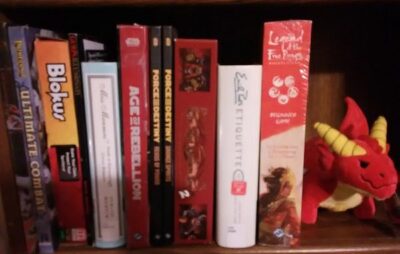
Etiquette & Protocol (E&P for short) is an occasional feature where I venture into the sometimes thorny OOC arena of good behavior in game groups, so that your tabletop doesn’t become a soda-bottle and dice mêlée field.
I consider making the gaming hobby better and safer a priority. To me this includes protection from harassment and bigotry. It also means keeping people safe from in-game content that would be triggering. Or even just something they simply don’t want in-game, for whatever reason. Yes, even if others are okay with it.
The TTRPG Safety Toolkit by Kienna Shaw and Lauren Bryant-Monk is a list of techniques groups can implement to ensure players and GMs can have fun, safely. It has brief descriptions of ways to do everything from find out what content players don’t want in a new game to give players a way to indicate discomfort mid-session to post-session suggestions. These aren’t extensive how-to’s. They are short descriptions with a Resource list at the end, for you and your group to find out more about the one/s you think would work for your games.
In addition to the Toolkit Guide, the Google Drive link above has a lot of related PDFs. There are printable cards for some of the tools (e.g., X-N-O, Script Change); translations of the Guide; and transcripts of panels and podcasts on the topic.
The Toolkit Guide isn’t just for friend and con games. “Safety in TTRPG Actual Plays” has suggestions for podcasts, live streams, etc. The information is limited (one column in a 4 page PDF), but it at least gives hosts a heads-up on the issues and tools. One of the extras is a crediting section for game developers who wish to incorporate the materials in their games.
Some of the resources were familiar to me, such as X-N-O Cards (X=stop, N=fade out/change/retro/etc., O=okay) and Lines and Veils (Lines = “hard no”/”don’t go there” content, Veils = offstage/”fade to black” is okay).
Several of the methods covered aren’t just for safety/comfort, but allow for other kinds of after-action feedback. Take Stars and Wishes. Stars are highlights – little things the player enjoyed, in-character or out. Wishes are things they want to see in future games, good information for the GM to have.
Not all resources will be equally useful for all groups, of course. In fact, I question how useful the Luxton Technique would be during games, as it seems to require quite a bit of talk and negotiation, which could take up a lot of gaming time, while not accomplishing any more than, say X-N-O cards or the similar but slightly more detailed Scripting Tools. Luxton Technique is best reserved, in my opinion, for after-action and wrap-up discussions. This isn’t a bad thing; several of the resources mentioned in the Toolkit have parts for post-session, as well as Session 0 and in-game.
Below is a list of other articles by my cohort Kim Frandsen and me on the topic, for further reading.
Related articles:
Finders Archives: Behavior at the Gaming Table (Kim Frandsen)
Finders Archives: Behavior at the Gaming Table II (Kim Frandsen)
Etiquette & Protocol – Review: Consent in Gaming from Monte Cook Games (Linda Whitson)
Etiquette & Protocol – Con Gaming (Linda Whitson) (#s 1 and 4)
